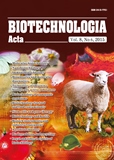ISSN 2410-7751 (Print)
ISSN 2410-776X (Online)

"Biotechnologia Acta" V. 8, No 6, 2015
https://doi.org/10.15407/biotech8.06.087
Р. 87-99, Bibliography 21, English
Universal Decimal Classification: 544.723:612.82:616.831-005.1-06-07
THE STATE OF THE WATER IN BRAIN TISSUE IN PRESENCE OF TS-100 NANOPARTICLES
T. V. Krupska1, S. V. Pakrishen2, O. V. Serov2, O. T. Volik3, V. V. Turov1
1Chuiko Institute of Surface Chemistry of the National Academy of Sciences of Ukraine, Kyiv
2The Post-mortem Department of Alexander Hospital, Kyiv
3The Medical and Pharmaceutical Faculty of Kyiv International University
By the method of low-temperature 1Н NMR spectroscopy the structure of the hydrate layers of water associated with brain cells, the changes of these parameters during necrotic lesions (stroke) and in the presence of trifluoroacetic acid, which allows differentiating intracellular water clusters according to their ability to dissolve the acid, were studied. Also the impact of silica TS-100 nanoparticles on the state of water in brain tissue, namely on the water binding parameters in the air and in the presence of a weakly polar solvent was considered.
The distributions by the radii and change of Gibbs free energy for clusters of strongly bound interfacial water were obtained. It was shown that the hydration properties of the native brain tissue differ from the hydration properties of necrotic damaged tissue by the structure of weakly bound water clusters. In intact tissue all the water is associated and is a part of clusters and domains, most of which have a radii R = 2 and 20 nm. The media with chloroform stabilizes water polyassociates with the radius up to R = 100 nm and trifluoroacetic acid stabilizes water polyassociates with radii R = 7–20 nm. It was found that the partial dehydration of the investigated tissue samples is accompanied by decreasing of weakly bound water amount and some increasing of strongly bound water that indicates a change of molecular interactions between the components of cells-nanoparticles composite system. The ischemic necrosis area presence leads to a decrease of water binding due to the average size water polyassociates increasing. This effect is observed both in air and in a weakly polar organic solvent medium (deuterochloroform).
Key words: ischemic stroke, the strongly and weakly associated water, 1Н NMR spectroscopy.
© Palladin Institute of Biochemistry of the National Academy of Sciences of Ukraine, 2015
References
- Therapeutic electrical stimulation of the human brain and nerves. Ed. red. N. P. Bekhtereva. Moskva: ACT; St. Petersburg: Sova; Vladimir: VKT. 2008, 464 p. (In Russian).
- Azin A. L, Gruzdev D. V., Kublanov B. C. The dynamics of intercellular transport in brain tissue (Radiophysical study approach). Vestnik novykh meditsinskikh tekhnologiy. 2002, 9 (4), 74–79. (In Russian).
- Wiegell M., Larsson H., Wedeen V. Fiber crossing in human brain depicted with diffusion tensor MR imaging. Radiology. 2000, V. 217, P. 897–903. http://dx.doi.org/10.1148/radiology.217.3.r00nv43897
- Bronge L. Magnetic resonance imaging in dementia. A study of brain white matter changes. Acta. Radiol., SuppL. 2002, V. 428, P. 1–32. http://dx.doi.org/10.1034/j.1600-0455.43.s.428.1.x
- Berezov T. P., Korovkin B. F. Biological Chemistry. Moskva: Meditsina. 1998, 704 p. (In Russian).
- Block. R. E. Factors Affecting Proton Magnetic Resonance Line-widths of Water in Several Rat Tissues. Federation European Bio-chem. Soc. Lett. 1973, V. 34, P. 109–112.
- Carr H. Y. Purcell E. M. Effects of Diffusion on Free Precession in NMR Experiments. Phys. Rev. 1954, V. 84, P. 630–638. http://dx.doi.org/10.1103/PhysRev.94.630
- Clifford J., Pethica B. A., Smith E. G. A Nuclear Magnetic Resonance Investigation of Molecular Motion in Erythrocyte Membranes. In: L. Bolis and B. A. Pethica (Eds.). Membrane Models and the Formation of Biological Membranes. Amsterdam: North Holland Publishing Co. 1968, P. 19?42.
- Damadian R. Tumor Detection by Nuclear Magnetic Resonance. Science. 1971, V. 171, P. 1151–1153. http://dx.doi.org/10.1126/science.171.3976.1151
- Gun’ko V. M., Turov V. V., Gorbik P. P. Water on interfaces. Kyiv: Naukova dumka. 2009, 694 p. (In Russian).
- Gun'ko V. M., Turov V. V. Nuclear Magnetic Resonance Studies of Interfacial Phenomena. Taylor & Francis, New York. 2013, 1076 p. http://dx.doi.org/10.1201/b14202
- Turov V. V., Gun’ko V. M. The clastered water and ways of its applications. Kyiv: Naukova dumka. 2011, 313 p. (In Russian).
- Gun’ko V. M., Turov V. V., Bogatyrev V. M., Zarko V. I., Leboda R., Goncharuk E. V., Novza A. A., Turov A. V., Chuiko A. A. Unusual properties of water at hydrophilic/hydrophobic Interfaces. Adv. Coll. Interf. Sci. 2005, V. 118, P. 125–172.
- Aksnes D. W., Kimtys L. Characterization of mesoporous solids by 1H NMR. Solid State Nuclear Magnetic Resonance. 2004, V. 25, P. 146–163. http://dx.doi.org/10.1016/j.ssnmr.2003.03.001
- Petrov O. V., Furo I. NMR cryoporometry: Principles, application and potential. Progr. NMR. 2009, V. 54, P. 97–122. http://dx.doi.org/10.1016/j.pnmrs.2008.06.001
- Kinney D. R., Chaung I-S., Maciel G. E. Water and the Silica Surface As Studied by Variable Temperature High Resolution 1H NMR. J. Am. Chem Soc. 1993, V. 115, P. 6786–6794. http://dx.doi.org/10.1021/ja00068a041
- Turov V. V., Gun’ko V. M., Turova A. A., Morozova L. P., Voronin E. F. Interfacial behavior of concentrated HCl solution and water clustered at a surface of nanosilica in weakly polar solvents media. Coll. Surf. A: Physicochem. Engin. Asp. 2011, 390 (1), 48–55. http://dx.doi.org/10.1016/j.colsurfa.2011.08.053
- Turov V. V., Todor I. N., Lukianova N. Yu., Krupskaya T. V., Ugnivenko A. P., Chekhun V. F. Effect of trifluoroacetic acid in water clustering partially dehydrated rat liver Guerin carcinoma. Dopovidi NAN Ukrayny. 2014, N 2, P. 129–133. (In Russian).
- Thermodynamic properties of individual substances. Ed. V. P. Glushko. Moskva: Nauka. 1978, 495 p. (In Russian).
- Turov V. V., Gun'ko V. M., Zarko V. I., Goncharuk O. V., Krupska T. V., Turov A. V., Leboda R., Skubiszewska-Zi?ba J. Interfacial Behavior of n-Decane Bound to Weakly Hydrated Silica Gel and Nanosilica over a Broad Temperature Range. Langmuir. 2013, V. 29, P. 4303–4314. http://dx.doi.org/10.1021/la400392h
- Krupskaya T. V., Prylutskyy Yu. I., Evstigneev M. P., Tsapko М. D., Turov V. V. 1H NMR characnerization of nanoscale aqueous structure in zoogloea Tibetan milk mushroom: influence of hydration and hydrophobic environment. Zh. pricladnoy spektroskopii. 2015, 82 (3), 341–347. (In Russian).

